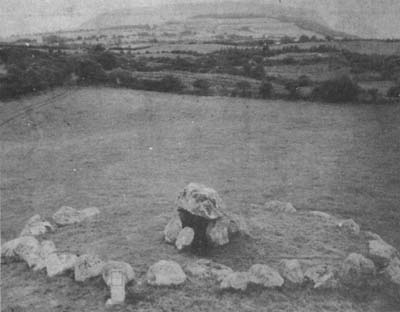Gravel Extraction Threatens Vital Megalithic Tomb
Professor O'Kelly of UCC claims the tomb is even older than Newgrange - Donal Musgrave reports.
One of the graves at Carrowmore with Knocknarea Mountain in the background - Photo by Goran Burenhult
One of Ireland's most important megalithic tomb sites, believe to be at least 1,000 years older than those of the Boyne Valley and to hold the key to one of the great mysteries of Irish archaeology is in danger of being destroyed by commercial - gravel extraction.
This warning was given yesterday by Professor Michael Joseph O'Kelly of University College Cork on the eye of an international conference, which will investigate the significance of the great cemetery of passage graves at Carrowmore, five miles from Sligo, where recent discoveries have led to a heated archaeological debate which could result in important chapters of ancient Irish history being totally re-written.
Prof O'Kelly said yesterday that, since the discovery of 100 tomb sites at Carrowmore in the middle of the last century, 70 of the stones structures have been destroyed by commercial gravel extraction carried out by local farmers.
"There is now a real danger that some of the remaining 30 sites could be destroyed, "he claimed. "Continuing gravel extraction will undoubtedly endanger what is left of the cemetery. "The area should be acquired by the state under some arrangement which would not dispossess the farmers of their land," he said, "I believe the land should be limited to cattle grazing because tillage will destroy more tombs. Ideally all gravel extraction should be stopped in the vicinity of the passage graves and the farmers should be compensated by commercial gravel sales."
"We cannot exaggerate the importance of what has now been discovered at Carrowmore," he told me. The results have been so astonishing that all the current literature about this period of ancient Irish history will have to be re-thought and re-written. The whole story has to be changed.
Up to now, he explained, archaeologists have held that the megalithic settlers, who built the vast passage graves of Newgrange, Knowth and Dowth had come up to the River Boyne directly from Brittany and Britain and established a flourishing agricultural society in the Boyne Valley around 3,000 BC. They built the passage graves as part of the cult of the dead and then, it was thought, migrated westward to reach Carrowmore.
During the past five years, however, Swedish archaeologists led by Göran Burenhult have discovered by carbon dating that the ancient Carrowmore tombs are at least 1,000 years older than those of the Boyne Valley. According to Prof O'Kelly this proves beyond doubt that the tomb builders were not invaders or colonists from Brittany or Britain but that they were the original ancient Irish, hunters and gatherers of food who arrived here around 7,000 BC and settled at Carrowmore between 5,000 and 4,000 BC. They lived in wigwam-style huts on the upper slops of Knocknarea.
Boyne Valley Private Day Tour
 Immerse yourself in the rich heritage and culture of the Boyne Valley with our full-day private tours.
Visit Newgrange World Heritage site, explore the Hill of Slane, where Saint Patrick famously lit the Paschal fire.
Discover the Hill of Tara, the ancient seat of power for the High Kings of Ireland.
Book Now
Immerse yourself in the rich heritage and culture of the Boyne Valley with our full-day private tours.
Visit Newgrange World Heritage site, explore the Hill of Slane, where Saint Patrick famously lit the Paschal fire.
Discover the Hill of Tara, the ancient seat of power for the High Kings of Ireland.
Book Now

